Zuzlip Mountains
The mountain range west of the Zugnur Sea, where the oldest traces of life on Ranul were found.
Geography
The mountain range forms the western border of the Zugnur Sea, lying just outside Mustik Hamesi and north of the Seti Sielalnu.
It is the result of a tectonic plate being pushed away from Ranul's outer face and folding upwards in the process. The highest peaks are about 2.7 kilometers above sea level.
Many cave systems can be found throughout the mountains. Some of them are the result of the tectonic forces mentioned above, while those near the shoreline tend to be created by the sea water eroding the rock. Only few rivers run down towards the sea since most of the rain falls down before reaching the eastern-most ridge. However, part of the water from that ridge's western side finds its way through the cracked rock, resulting in a number of mineral-rich springs.
Localized Phenomena
There is a moderate level of radiation from Larevok, enough to cause irritations to skin that is exposed over longer periods of time.
Fauna & Flora
Vegetation is scarce in the mountains, consisting mostly of lichen, small succulents and hardy grasses. Stocky trees are occasionally found in valleys that gather water.
History
Pre-History
Several cave systems in the southeast contain paintings and carvings that can be dated back to around 140000 NZR. Archaeologists further found remnants of fireplaces, primitive tools and bones of early Rul subspecies. As far as is currently known, these are the oldest traces of civilization on Ranul.The Spring of Life
In the year 487 NZR, scholars first recorded the Nuorian legend of the so-called "Spring of Life" in writing. This spring allegedly possessed healing powers and was guarded by a group of priests who knew how to use them. Indeed, it appears that a temple existed about halfway up the easternmost ridge near what looks like a river bed. Little information exists about what happened to it. Geological studies lead to the conclusion that a groundquake altered the path of the water through the rock, causing the spring at the temple to run dry. Nevertheless, other mineral-rich springs in the area attracted similar attention over the ages. The Guardian of Identity mentions several such places that were frequented by pilgrims before the Final War. When the Rilsu later reclaimed the moon's surface, the old legend inspired people to establish a number of wellness resorts in these lands.Tourism
The Zuzlip Mountains see a fair amount of hikers, but their main attraction are the wellness resorts at the mineral springs. The most famous one is Numpeza Kegmi which is closest to what people believe was the original Spring of Life. Though neither that spring's healing powers nor its exact location were ever confirmed, those visiting the resort firmly believe in the rejuvenating effects of the water.
Type
Mountain Range
Location under
Included Locations
Related Myths





Great article. I enjoy the juxtaposition of mild radiation and healing springs. :D
Thank you very much! ^^ In fact, the whole "irradiated healing springs" idea comes from something one of my teachers told us at school. He said there was some cave system on Earth where low levels of radiation forced the body to fire up its healing mechanisms - but to prevent patients from freaking out, they were told that the caves would heal them with their nice, salty air. XD
Creator of the Kaleidoscope System and the planet Miragia.
Oh, that's a very cool story!